Many patients who can benefit from prosthetic contact lenses for either cosmetic improvement or therapeutic purposes are unaware of their existence. Although ocular disfigurement or asymmetry can be a sensitive subject, initiating the conversation can be very rewarding for both patients and practitioners. Prosthetic contact lenses can significantly improve the social relationships and well-being of patients.1
A variety of prosthetic contact lenses are available, each with their own unique features and limitations. Lens selection is guided based on need, therapeutic or cosmetic expectation, and cost. For some patients, they may have symptoms such as photophobia or diplopia. For others, the contact lens may be desired to mask a deformity or to improve cosmesis. Table 1 lists some of the common indications for prosthetic contact lenses.
| CORNEA | IRIS | LENS | GLOBE | OTHER |
|---|---|---|---|---|
|
|
|
|
|
Prosthetic evaluations present unique challenges with many contributing factors to success. It is important to determine whether a prosthetic contact lens is appropriate. In cases of phthisis bulbi in which there is a noticeable loss of orbital volume and the lid posture is affected, the patient is a better candidate for a scleral shell than for a prosthetic contact lens.2 It is also critical to determine whether the disfigured eye can tolerate and support contact lens wear. A temporary trial of a clear or disposable contact lens may be helpful in making this determination. This can be extremely helpful in patients who have a sensitive or compromised ocular surface, such as band keratopathy or bullous keratopathy.
The psychological and emotional state of these patients needs to be considered. Ocular disfigurement can cause emotional distress and low self-esteem. Eyes are an important part of non-verbal communication. Patients may be self-conscious, in particular if the change to their appearance is more recent. When initiating the conversation, patients needs to be reminded that a contact lens will not be able to duplicate their natural eye perfectly. Setting proper expectations avoids future disappointment. If the eye being fit is capable of vision, even if limited to the perception of light and movement, the patient should be educated on the vision changes that the contact lens may induce such as reduction of vision or change in perception.
Contrary to fitting most contact lenses, the majority of the measurements are taken on the healthy eye as opposed to the eye wearing the prosthetic lens. Important measurements of the contralateral eye include pupil size and horizontal visible iris diameter (HVID). The pupil size of a prosthetic lens is fixed. In addition, the light level of a patient’s typical wearing environment should be taken into consideration. Keep in mind that pupil asymmetry is more obvious in brighter light than in dim or dark light; therefore, most often pupil size is best measured in normal room illumination.
Other necessary information includes whether the lens is being fit on a sighted or non-sighted eye and whether a corrective prescription is needed. Patients who have a refractive error will likely want their prescription incorporated into the contact lens. Some manufacturers require a close-up photograph of a patient’s eyes. Iris color and detail assist in selecting the type of prosthetic lens. In particular, lighter-colored irises that have more unique variations often require a hand-painted lens to achieve a realistic color match. In contrast, a brown or darker-colored iris that has more uniform pigment can attain a suitable cosmetic match with an iris occlusion or computer-generated opaque design.
Some manufacturers supply the contact lens, while other laboratories provide tinting and coloration only. It is important to research the capabilities of each manufacturer including what customization options they offer. Not all lens designs are available with decentering iris/pupil detail or offer as many choices of pupil and iris diameter. Understand the return policy and the remake policy of the specific laboratory, especially for more custom contact lenses.
There are three general types of prosthetic contact lenses: translucent tinted lenses, computer-generated printed lenses, and hand-painted lenses (Figure 1).

TRANSLUCENT TINTED
Translucent tinted designs enhance a patient’s eye color or alter a patient’s perception. They have one uniform iris color with varying pupil options. Lighter-colored transparent tints allow the eye’s natural detail to still be visible; therefore they do not function well as an artificial iris. Darker brown translucent tints are capable of masking irregularities (Figure 2). Pupil choices include a translucent tinted pupil, clear pupil, or black pupil.
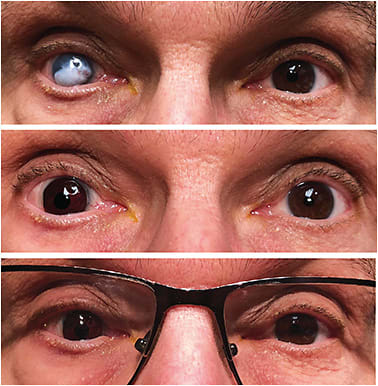
Translucent tinted lenses are also worn by patients who require a colored filter on one or both eyes to enhance visual function. This includes low-vision patients, color-deficient patients, or sports enthusiasts. The specific color required to obtain the desired effect may vary among patients and take some trial and error.
Patients should be aware that the lenses may affect their perceived eye color. This is particularly important for patients who have lighter-colored eyes or for lenses that have more intense tint colors such as a unilateral red lens worn for color deficiency.
COMPUTER-GENERATED
Computer-generated prosthetic contact lenses have a predetermined iris color and pattern with a more limited range of iris and pupil sizes in specific incremental steps. Many computer-generated designs intermix or layer several colors to achieve a more realistic effect. Iris detail over an opaque backing offers full iris occlusion and masks any underlying irregularity. If no opaque backing is specified, only partial iris occlusion will result, and some of the natural iris detail will be visible. When patients have very dark-colored eyes, solid black lenses can be the best color match (Figure 3). For some lens designs, the color of the underprint, such as black or gray, can alter the final perceived iris color.

Some manufacturers offer diagnostic fitting sets that include enhancements such as a limbal ring or pupillary frill along with the iris coloring (Figure 4). Other companies have preset designs such as a white opaque backing with a variety of iris tints, and the iris and limbal pattern are overlays that are already incorporated. Most lenses are available with either a clear or black pupil. Computer-generated lenses have good reproducibility and are less expensive compared to hand-painted lenses.

HAND-PAINTED
Hand-painted lenses offer a total customized appearance. Specific details from iris nevi to a painted sclera with blood vessels can be incorporated. The iris artistry can easily be decentered to improve alignment with patients’ natural iris detail (Figure 5) or to cosmetically correct eye alignment in cases of strabismus.
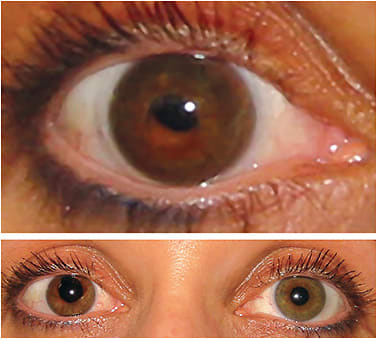
Most manufacturers request a close-up high-quality digital photo of both eyes. The camera should be held directly in front of patients at their eye level. Lighting for the photo is important for true color matching and should be consistent among the appointments. Check with the specific laboratory on recommendations or requirements. In most cases, the laboratory will then send color samples. Photos of patients wearing the color samples are taken so further adjustments can be made, if needed. Once a color sample is approved, a final lens is manufactured and the color sample is stored at the laboratory for manufacturing future lenses for that specific patient.
The process for fitting a hand-painted lens is more drawn out than for other prosthetic lenses and requires a longer manufacturing time. Patients should be aware that it could take up to six months from the start of the fitting to delivery of the final contact lens. Currently, hand-painted lenses are restricted to soft materials; however, hand-painted scleral contact lenses were at one point available and will likely be reintroduced in the not-too-distant future.
Hand-painted lenses have a greater variance in reproducibility. The coloring of the lens may fade with time. Some lenses can be repainted, while others will need to be replaced (Figure 6).
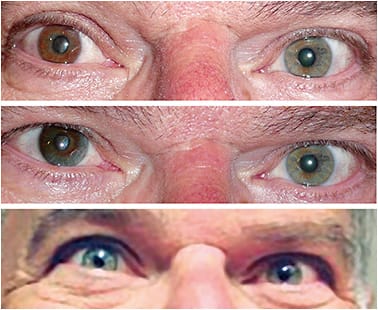
Preferred cleaning and disinfection products for each type of lens vary. It is important to note that some lens care products can accelerate the fading process. Consult the lens manufacturer for specific recommendations.
In certain cases, fitting both eyes with a colored contact lens can be helpful in achieving a desired color match. Keep in mind that a different choice of colored lens may be appropriate for each eye. For example, one light-eyed patient who wanted to avoid the expense of a hand-painted prosthetic lens was fit with a computer-generated opaque lens that has an underprint to create an artificial pupil on her right eye and a frequent replacement colored contact lens on her left eye (Figure 7). If a prosthetic contact lens patient is monocular, it is advantageous to wear impact-resistant glasses for protection. Glasses worn over the contact lens can further enhance the cosmesis, especially when a light or gradient tint is incorporated into the spectacles. In addition, the power of the glasses can be used to alter the perceived size of a disfigured eye when applicable; plus power creates a magnification effect whereas minus power creates a minification effect.
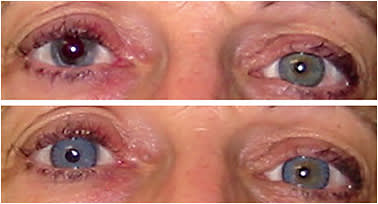
Some manufacturers offer fitting sets or sample lenses for patients to trial in-office. Diagnostic lenses are helpful in establishing an acceptable color match and contact lens fit. When the contact lens does not perfectly center on the eye, the iris detail needs to be decentered on the contact lens to achieve a realistic cosmetic appearance. In these cases, a prism-ballasted contact lens is used to establish consistent orientation of the contact lens (Figure 8). A larger diameter lens may be necessary to allow enough space for the decentration. Hand-painted lenses allow for decentration of iris and pupil detail, as do some of the computer-generated and translucent lens designs. It is recommended for practitioners to contact the laboratory directly and speak with a consultant to determine whether this option is offered from that specific manufacturer.
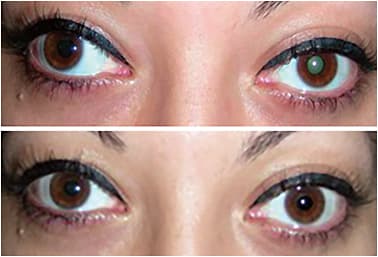
Be aware of the warranty and return policies of a specific laboratory prior to initiating the fitting process. If a prosthetic contact lens is not returnable, it is advantageous to fit a clear version of the same lens in the desired base curve and diameter to first confirm proper fit and contact lens tolerance. Verify that patients are able to manipulate the contact lens and to perform lens application and removal. Have patients wear the clear lens for a week, then return for a follow-up visit prior to ordering the final prosthetic lens. Typically, the clear contact lens is returnable, but the custom colored prosthetic version is not.
The majority of prosthetic contact lenses are recommended to be replaced annually. Frequent replacement colored lenses offer more convenience and quick, easy accessibility; when used for prosthetic purposes, however, they are of limited use in masking a deformity or creating an artificial pupil.
NON-PROSTHETIC APPLICATIONS
Not all colored contact lenses are used for prosthetic fitting. Some patients want to enhance or change their eye color for cosmetic purposes. Colored contact lenses are available in a range of designs including opaque colors, enhancer tints, or limbal patterns and can be prescribed for either full- or part-time wear. Patients seeking cosmetic lenses for occasional wear are good candidates for a daily disposable design. Annual replacement as well as two-week and monthly replacement options are available as well. Colored contact lenses are offered both with and without refractive correction; however, choices for anything other than a spherical power are limited.
When discussing colored contact lenses, it is important to establish the cosmetic result that patients are hoping to achieve, whether it be a subtle natural change or something more dramatic. Opaque contact lenses are helpful in allowing patients to change their eye color (e.g., patients who have darker irises who want to lighten their perceived color) (Figure 9). Enhancer tints are primarily used for patients who have light irises to alter the shade and intensity of their eye color. Limbal designs can boost and define a patient’s natural eye color (Figure 10). Oftentimes, non-prescription colored sample lenses are available for patients to try on in-office. Taking into consideration the overall desired appearance, along with a patient’s skin tone and natural eye color, helps to guide trial lens selection and reduce chair time.
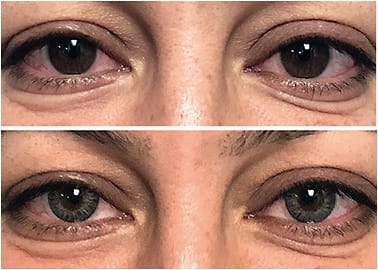
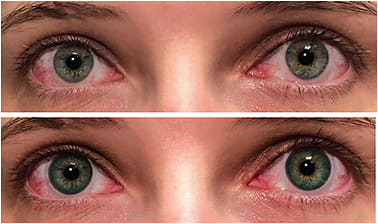
Some colored contact lenses are intended to create a special effect for theatrical or novelty purposes. Actors wear cosmetic lenses to create a specific look for character roles. Other patients may seek a novelty contact lens for a special event or holiday such as Halloween (Figure 11).

Remind your patients that contact lenses are medical devices, even if worn only for cosmetic purposes. The contact lenses must be fit and prescribed by a qualified eyecare provider. Cosmetic contact lenses should not be purchased without a valid prescription. Proper handling and disinfection techniques need be followed to safely wear these lenses and to avoid contact lens-related infections or inflammatory events.
CONCLUSION
Taking initiative in recommending prosthetic contact lenses can make a tremendous difference in the lives of your patients. Whether you provide the service in your office or refer patients to a prosthetic lens specialist, they will be grateful that you are able to help them improve their quality of life. CLS
REFERENCES
- Yildirim N, Basmak H, Sahin A. Prosthetic Contact Lenses: Adventure or Miracle. Eye Contact Lens. 2006 Mar;32:102-103.
- Cote RE, Haddad SE. Fitting a prosthesis over phthisis bulbi or discolored blind eyes. Adv Ophthalmic Plast Reconstr Surg. 1990;8:136-145.




